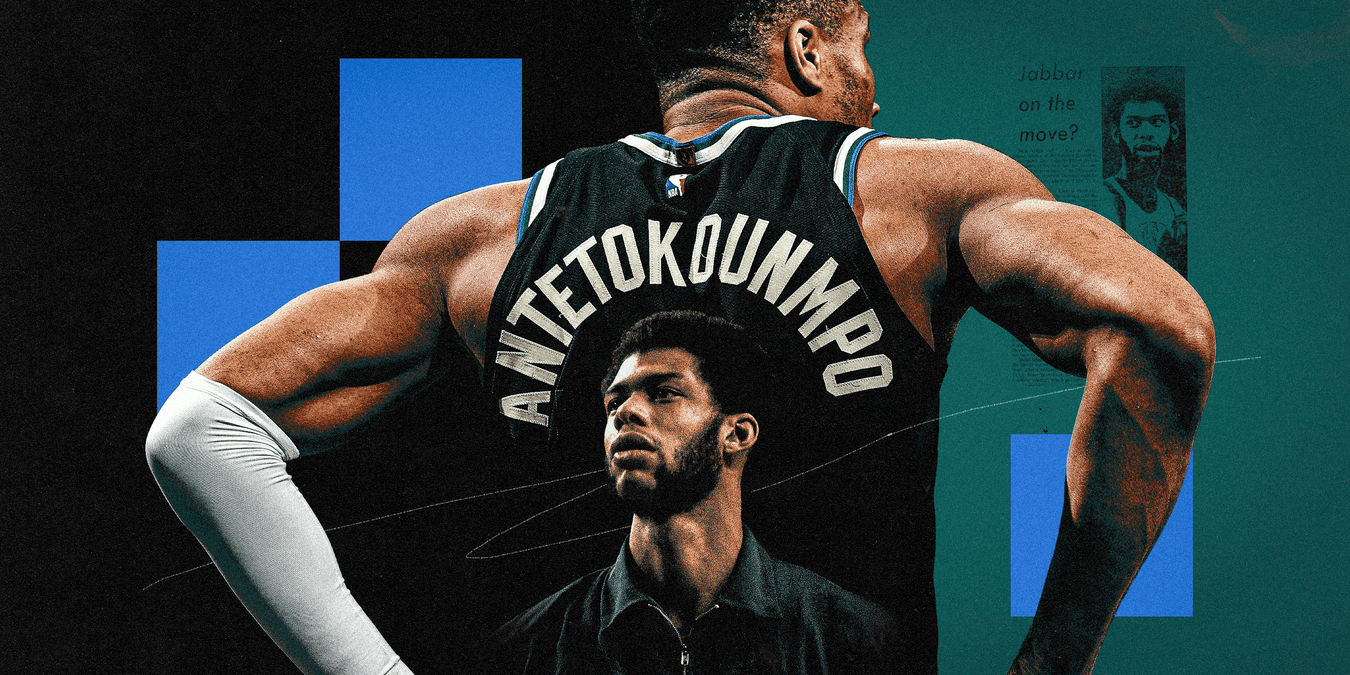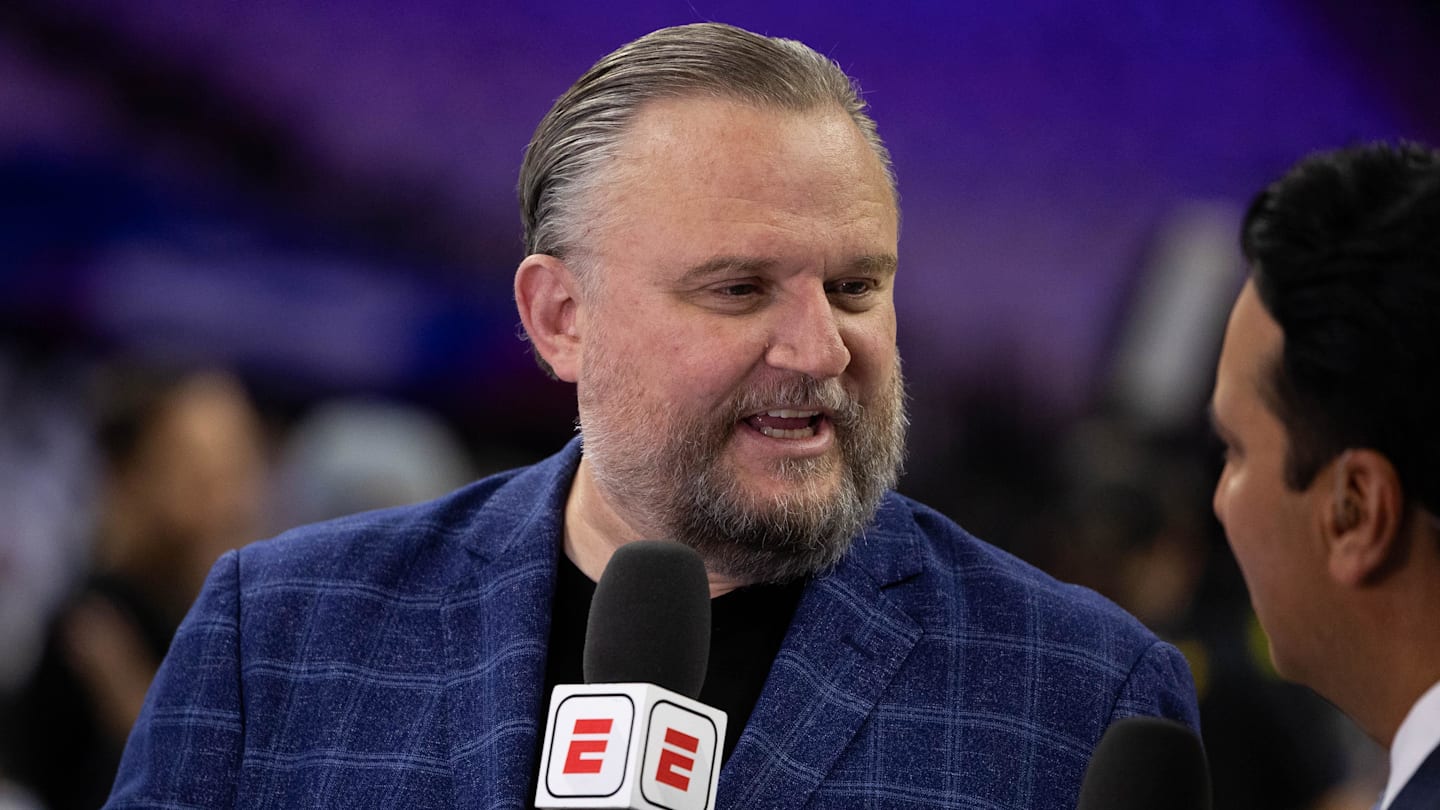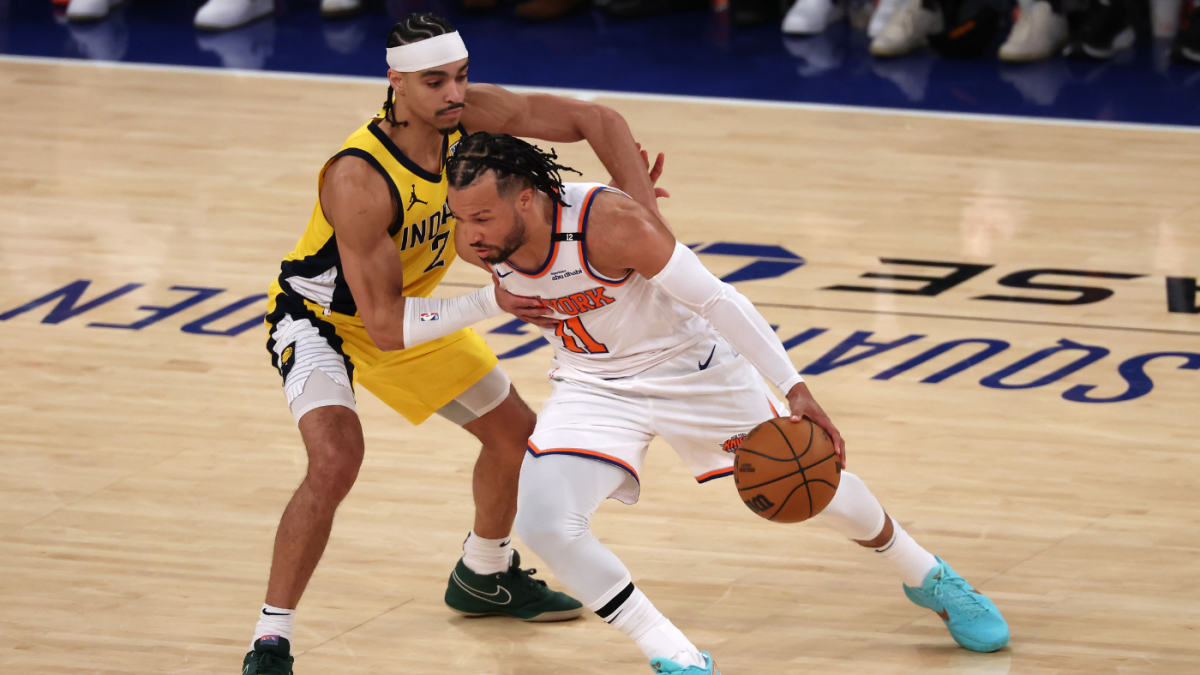MILWAUKEE (somewhere in my memories) — Throughout my early childhood in Milwaukee, Kareem Abdul-Jabbar loomed large.
Kareem played for my hometown Bucks, and he was everywhere: on the front page of our two sports sections, on the cover of magazines, on ABC’s nationally televised games and later on CBS hitting “a big pressure shot” at Boston Garden against the Celtics in Game 6 of the 1974 NBA Finals.
But for me and my wild imagination, there was no more symbolic representation of Kareem’s outsized presence than a brilliant electric sign festooned with flashing bulbs and neon for a electronics store near the old Capitol Court mall on Milwaukee’s near Northwest side: The sign was wide at the top, narrowed in the middle, and the middle shifted to one side, right or left depending on how you approached it. The bottom of the sign narrowed into an arrow pointing to the store.
Advertisement
For that establishment, it was a glowing acknowledgment that it was ready for your business. For me, it looked like a net at Milwaukee Arena after Kareem swished a skyhook from the baseline.
“Yeah, I can see that,” my dad said after I mentioned it once as we drove past.
You can see it, too. It looked like this net on this Sports Illustrated cover.
That I still have that memory from half a century ago is a stark reminder of greatness: Stars will make occasional impressions, but superstars imprint themselves deep in your memories and deep in your imagination.
This is why the constant speculation surrounding Giannis Antetokounmpo worries Bucks fans. They know what they have with Giannis: a singular and single-named superstar who has already delivered an NBA title — the franchise’s first since … Kareem.
So, I proffer this advice to Bucks: Hold on to the Greek Freak for dear life. Do not let him go. Do not trade him to the highest bidder. I don’t care if the Dallas Mavericks throw in the No. 1 pick, more draft picks and Jerry World (scratch that; the Green Bay Packers already own AT&T Stadium). Or the Rockets offer Alperen Şengün, more draft picks and NASA Mission Control. Or the San Antonio Spurs give up this year’s second pick, Stephon Castle, more draft picks and The Alamo. For Bucks fans, Giannis is their historic landmark.
Do something radical and resist the urge to send the greatest player in franchise history to another NBA team because you think a surfeit of draft picks and a couple of rebuilding seasons is better in the long term.
If the Bucks trade Giannis, the franchise could wander through an interminable, title-less winter for decades.
How do Bucks fans know this? They have lived it already. Making them go through it again could be too much to ask.
The circumstances surrounding Kareem then and Giannis now are different, but there are parallels.
For his six seasons in Milwaukee, Kareem had not only established himself as the best Buck ever but also cemented his place as one of the greatest players ever, college or pro.
He had already won three consecutive NCAA titles at UCLA. He was the surest of sure things. How sure? Watch then-Suns GM Jerry Colangelo’s soul leave his body when Phoenix loses the coin flip that gave Milwaukee the right to the No. 1 pick in the 1969 NBA Draft. He knew that moment was a franchise- and NBA-defining event.
Advertisement
Kareem left an indelible imprint on that era’s Bucks fans because of his burgeoning professional resume. He won Rookie of the Year in 1970, NBA Finals MVP in 1971, when Milwaukee swept the Baltimore Bullets as the Bucks went from an expansion team in 1968 to NBA champs in three years — the fastest ascension to the mountaintop in any sport’s history. He was named NBA MVP in ’71, ’72 and ’74. He led the NBA in scoring in ’71 and ’72 and carried the Bucks to another NBA Finals in 1974.
But one year after that second finals appearance, he was gone. Abdul-Jabbar found Milwaukee socially stifling, as then-Bucks GM and now Naismith Hall of Famer Wayne Embry told the Los Angeles Times in 1987.
“We asked Kareem if there was dissatisfaction with us and he said, no, he just wanted to be traded from Milwaukee,” Embry said. “He said his lifestyle and the lifestyle in Milwaukee were not compatible.”
While that hurt Milwaukeeans at the time, it was understandable given that Kareem grew up in New York and went to college at UCLA. So Kareem asked out and noted that he wouldn’t sign another contract in Milwaukee. Big-market sharks, the Lakers and the Knicks — “(The Knicks) asked us,” Embry disclosed to The New York Times, “what it would require for them to get Kareem in a trade” — began circling in Lake Michigan. Kareem had forced the Bucks’ hand.
On June 16, 1975, that hand reached out to the Los Angeles Lakers.
“In a deal that reshapes the face and possibly the future of pro basketball,” Steve Cady wrote in The New York Times, “the Milwaukee Bucks traded Kareem Abdul‐Jabbar yesterday to the Los Angeles Lakers.”
Prescient words from Mr. Cady. The deal did reshape the future of pro basketball. Kareem went on to add three more NBA MVPs for a record six. He won five more titles with the Lakers while setting the NBA’s all-time scoring record, a mark he held for 38 years. In return, the Bucks received four players, two of whom, Brian Winters (No. 32) and Junior Bridgeman (No. 2), had their numbers retired with the Bucks after successful careers in Milwaukee.
Advertisement
The Bucks, though, wouldn’t return to the NBA Finals for 46 years.
That’s not to say the Bucks were destitute for more than four decades. There were great times, moments and players. The Bucks won multiple division titles and also made four Eastern Conference finals between 1982 and 2001, but could never get past the Celtics or the Philadelphia 76ers.
Because, as good as the Bucks were with their All-Stars, they didn’t have superstars such as Larry Bird or Moses Malone or Julius Erving or later Allen Iverson. (All NBA MVPs by the way.)
Superstars give fans hope and their teams a chance. Superstars leave their peers in awe. Superstars change a franchise’s direction. And that’s exactly what an unknown Greek project did more than a decade ago.
Between trading Kareem in June 1975 and drafting Giannis in June 2013, the Bucks had players score 40 or more points 36 times, including only 11 times between 1975 and 1989 and no one in the three seasons before Milwaukee drafted Giannis. He has scored 40 or more 54 times and reached or surpassed the 40-point plateau 12 times in the 2022-23 season alone.
In the same Kareem trade-Giannis draft timeline, Milwaukee had three occasions where a Buck scored 50 or more points. Giannis has tripled that with nine, including a franchise-record 64 in 2023. It’s why teams build a wall of defenders to stop him.
Then there are the two NBA MVPs, seven consecutive First Team All-NBA nods, nine All-Star Games, a Defensive Player of the Year award in 2020, and, most importantly, an NBA Finals MVP, with a 50-point performance in Game 6 against Phoenix that clinched the championship for Milwaukee, its first in 50 years.
By any definition — league-wide awards, foes’ fear factor, compensation, popularity — Giannis is a superstar.
That Giannis is known to the world. Then there’s the Giannis that is familiar — or familial — to Bucks fans.

Few NBA fans knew who Giannis Antetokounmpo was when the Bucks drafted him in 2013. (Photo by David Dow / NBAE via Getty Images)
He was 18 years old, a skinny 6-9 and 215 pounds after Milwaukee nabbed him with the No. 15 pick in the 2013 draft. Like most draft picks, he wasn’t a sure thing. He was an unknown to most Bucks fans (as were, frankly, most of the Bucks at the time).
“The Bucks decided to swing for the fences with Antetokounmpo,” ESPN.com wrote in 2013. “He looks a little like Kevin Durant. He can handle the ball, he can shoot the 3, and he’s got a crazy wingspan.
Advertisement
“But he has Q-tips for legs, has been playing in the equivalent of a rec league in Greece and looks years away from being NBA-ready. He will be a home run or a bust, but we won’t know which for a couple of years.”
Antetokounmpo’s precociousness endeared him to the Bucks’ fan base. Tasting a smoothie blew his mind. As a rookie, he wired money home, but he didn’t have enough for a cab back to the Bradley Center, then the Bucks’ home. So he started running to make pregame warm-ups before a kindly couple offered him a lift. He toured the BC with his parents, looked to the rafters and wondered if one day his jersey would join greats such as Oscar Robertson, Sidney Moncrief and, yes, Kareem.
The player with “Q-tips for legs” grew up in Milwaukee, and the franchise and its followers grew with him. Bucks fans embraced him, and he returned that embrace.
None of that would have mattered had he not produced on the court. He could do things Bucks fans had never seen one of theirs do before, such as dunking from just inside the free-throw line in a game or jumping over a player in a game for a dunk.
Then, there was the change in attitude. Giannis brought an edge (or as Richard Jefferson noted, Antetokounmpo’s default setting on the court is “always pissed”) that great players often have as a part of their DNA. That edge has set the tone for the Bucks for the past decade. That edge, which teams covet, is why the “Where will Giannis play next?” speculation has reached its zenith.
Giannis has been clear about his desire to compete for NBA titles. Since winning one in 2021, the Bucks have won one playoff series and have three consecutive first-round exits since 2023. Injuries — to Khris Middleton in 2022, to Giannis in 2023, to Giannis and Damian Lillard in 2024 and to Lillard again in 2025 — have played a part, as has an aging core and the slow development of younger players.
Knowing that Giannis (and Bucks fans) want titles, the front office has done everything in its power to keep Giannis in Milwaukee and compete. The roster has been one of the NBA’s more expensive for the last five years. In 2020, the Bucks traded for point guard Jrue Holiday. When Holiday’s ability as a second-offensive option waned and Middleton’s health didn’t improve, the team traded Holiday for Lillard in 2023, who himself asked out of Portland, because he, too, wanted to compete for a title. Pairing Giannis and Dame, two NBA 75 Team members, seemed smart.
Advertisement
Because of these moves, the Bucks have few future draft picks and little financial flexibility to make a big splash. With Lillard out for most of next season because of a tear to his left Achilles and only four players, including Antetokounmpo and Lillard, signed for next season, the Bucks could be in for a rough 2025-26. The NBA championship outlook is even more dour.
Giannis could survey that landscape, look at what he’s done in Milwaukee, secure in the knowledge he has given the organization and the city everything he’s had, and say, “Yeah, it’s been great, but…”
Like Kareem, that would be hard to take, but easy to understand. Sports legacies are built on championships. The more you have, the higher you climb. Multiple titles are the only thing Giannis is missing from his resume.
But Giannis hasn’t yet gone to the Bucks brass and asked out, though numerous NBA fan bases, some media outlets and countless social-media accounts are salivating at the thought.
Even if Giannis requests a trade, the Bucks should think (and think and think) about not acquiescing. Giannis is under contract for two more seasons with a player option for 2027-28. They don’t need to trade him now. Maybe have a gap year. It could be better to be meh with Giannis than a mess without him.
With Jayson Tatum’s Achilles injury and the Celtics’ looming salary-cap crunch, the Eastern Conference’s calculus has changed. Could Giannis and a younger core, one he won eight consecutive games with to end this season, have a little bit of hope in the East? And with the punitive second-apron payroll threshold in this current collective bargaining agreement, the return to relevance might not take as long as it once did, as parity has come to the NBA.
While superteams may be on the wane, superstars will always — always — be valuable.
Advertisement
That’s why legendary San Antonio Spurs coach Gregg Popovich, one of the greatest in history in any sport, toasts his franchise’s greatest player whenever he sits down to a meal.
One can only imagine how many mugs of beer have been lifted and clinked in Giannis’ honor as the bond between a superstar and a small market is special. Because, as Popovich and every NBA coach know, superstars change everything.
When you have a superstar, your franchise goes from opponents making your arena their playground …
Dwyane Wade on iconic 2010 play with LeBron:
‘It don’t matter how many times I say this. People don’t understand that was not a lob… I threw a bounce pass’
(via Trophy Room with Candace Parker) @att pic.twitter.com/gJ5GR9jwgl
— Bleacher Report (@BleacherReport) February 16, 2025
… to having a king:
Look, Giannis. Everything the light touches is your kingdom. pic.twitter.com/woSGA0oaMu
— Jenny Fischer (@jennylynnfisch) July 22, 2021
The Bucks must ask themselves: Can they find a player who averages 30 points, 11-plus rebounds, six assists per game on 60-percent shooting? (No, because Giannis is the only player to do it, and he’s done it in back-to-back seasons.) Can they replace that with future draft picks and the hope that someone, possibly with skinny legs and an unceasing drive to improve, will come along and be as good? Or even half as good? Can they find someone in a trade who has moved and energized and engendered the eternal goodwill of a fan base, a city, a state?
The answer is most likely no. And that’s what the Bucks should say to any trade offer.
Milwaukee and its fans have given Giannis a chance, and they have loved him. Giannis has given them everything else: dedication, determination and a championship. As Bucks fans know all too well, should the bond between their small-market franchise and its superstar be broken, any bright future could be far in the distance.
And you don’t need a big, brilliant, blazing electronic sign to tell you that.
(Illustration: Will Tullos / The Athletic; Photos: Jeff Haynes, Dick Raphael / Getty Images)



